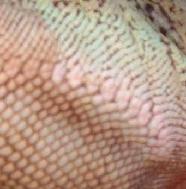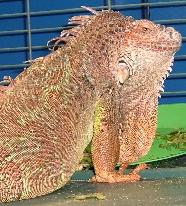|
SEXING YOUR IGUANA
You wonít be able to tell the difference until the iguana has had its first breeding season. This typically happens when it reaches a size of 9-12 inches from its snout to vent. (stv)
With proper care, a hatchling could reach this size in about two years. Too often, older iguanas that were not fed the right food, or not given the right husbandry, have been stunted. If thatís the case, they might be older than two years when they go into their first breeding season. Thatís why size is a more accurate way of telling when to expect the onset of the first breeding season.
|
EVERYTHING YOU ALWAYS WANTED TO KNOW ABOUT IGUANA
SEX, BUT WERE AFRAID TO ASK!
|
Letís assume your iguana is at least nine inches stv, and is a male. You will notice that his cheeks are getting a little ďjowl-yĒ or puffy. Look at the underside of his thighs and you will see large circular ďholesĒ that have a white-ish substance protruding out of them. These are called the femoral pores because they run along the femur bone of his thigh. Both males and females have femoral pores, however, the males are much more pronounced when sexually mature, and especially during breeding season, will exude a waxy type substance.
His coloring will possibly turn more orange starting with the extremities. The orange color will work itís way from the feet and hands up the arms and legs and may go as far as the neck and back.
His behavior will change too. Restlessness, and aggressiveness are common. Your male iguana has strong mating urges and he will become more territorial. He will want to patrol his area more often looking for intruders, or females ready to mate. The male iguana will also be able to ďsmellĒ human female hormonal changes. Women who are ovulating, or menstruating might have episodes where their male iguana will attempt to mate with them. While this may seem funny at first, keep in mind that the male iguana holds the female down by grabbing the back of her neck with his mouth. They have extremely sharp teeth that can give a serious bite, even if the iguana is not being malicious. This is the exact type of maneuver he will try on his human female keeper. If his human female keeper has a husband or boyfriend, he might become the target of the iguanas breeding season aggression too. The human male now might be considered a rival or intruder. Whereas before, the man of the house would be able to pick up your previously friendly male iguana, now the iguana takes on a whole different personality. He might lunge, or even try to bite.
Itís important to remember, that the iguana is acting out of his own powerful hormonal drives. Perhaps if the men and women of the house would remember their own puberty, they can have some sympathy for their green friend. It lasts for a few months, and usually the worst is a short period of time. From the onset of breeding season, ramping up to the height of it and tapering off, it could take 3-4 months. The worst of it is probably going to be in the middle of that time frame and will be the shortest.
|
 |
| Femoral pores courtesy of Pumpkin |
|
|
 |
| Female femoral pores courtesy of Bonita |
|
|
 |
| Puffy cheeks courtesy of Pumpkin Kahuna |
|
|
THE FEMALE BREEDING SEASON
|
YOUR FEMALE IGUANA WILL GO THROUGH CHANGES OF A MORE PHYSICAL NATURE THAN THE MALE. HOWEVER, THERE ARE BEHAVIORAL CHANGES TO LOOK FOR TOO.
|
 |
| PIP before her spay |
|
|
Females will become gravid which means they are producing eggs. Much like chickens, they will lay eggs whether or not they have mated. There are females who will resorb their eggs, but itís better to assume she will lay eggs and be prepared to have a nest box suitable for her. Younger females will start out laying only about two dozen eggs. But as she gets older and bigger, the female iguana is capable of producing more than sixty eggs.
To understand the needs of the female iguana, letís take a look at what happens in the wild. Because iguanas donít have a diaphragm, her whole body cavity, will fill up with eggs. As this happens, she will find it harder to eat, as the eggs will be pressing on her internal organs. She will go off feed for the last part of her breeding season right before she deposits her eggs. At that time, she will use up the fat she has stored in her hips, thighs and the base of her tail.
She will also become more restless right before egg laying. She is looking for a place to lay her eggs. It will usually be found along a sandy riverbank where she will dig down about a foot and tunnel about six feet and dig out a cavern. There, she will deposit her eggs to incubate and hatch, without her.
Her job is done, and she will emerge from the nesting site looking like a walking skeleton. She has used up her stored fats and is exhausted. For the captive, pet iguana, if she doesnít have the right place to deposit her eggs, she might hold them in until they rot. This is a potentially life threatening situation as a serious infection of the body cavity can occur, also known as peritonitis. Or she might become egg-bound and will not be physically able to lay her eggs. This is known as dystocia and is fatal if not treated by a vet. Most times surgery is required to remove the bound eggs.
|
 |
| PIP dug out the sand in the corner |
|
|
 |
| PIP post surgery |
|
|
|